JUST Report
SURVEY ANALYSIS: Companies Are Committing to DEI Initiatives, but More Work Is Needed to Increase Accountability and Action
- More Reports
- View all JUST Reports
Kelley-Frances Fenelon, Michelle Mullineaux, and Jennifer Tonti contributed to this report. Published Nov 2, 2021.
Key Takeaways
- A year into our nation’s racial reckoning, companies have advanced diversity, equity, and inclusion (DEI) programs in their organizations.
- Most employers (94%) and workers (74%) say that their organization has made a commitment to advancing DEI in the workplace.
- Large majorities of employers (95%) and workers (83%) agree that these programs can be effective in creating a diverse, equitable, and inclusive workplace.
- But companies still have a ways to go in effectively implementing these commitments, building accountability, and driving concrete action toward change.
- Workers and employers diverge in their perspectives on whether their organizations have established a formal DEI program with clearly defined goals (49% workers compared to 69% employers). Additionally, one in four workers say they are “not sure” how much progress the organization has made.
- Employers and workers alike have split opinions on their assessment of how far companies have progressed in implementing DEI programs, with equal percentages in both groups saying their company has gone “above and beyond” (43% average) vs. “there’s still a way to go” (43% average).
- One driver of stalled progress may be that management hasn’t invited enough input or feedback from the right constituents. Just one in three employers reports having sought feedback from underrepresented groups.
Tracking Public Sentiment and Corporate Action Around Racial Equity
Over the past year – following the killing of George Floyd and subsequent reckoning with our nation’s history of systemic racism – there has emerged a renewed focus on inequities in the American workplace, where persistent social and economic inequalities experienced by BIPOC (Black, Indigenous, and people of color) employees are uniquely acute. Addressing these inequities is a “system-level challenge,” according to a 2021 McKinsey report focusing specifically on the experiences of Black workers, necessitating that employers consider facets from geographical inequity to industry underrepresentation in order to build greater workplace opportunity.
In an effort to more clearly understand the actions corporate America is currently taking to advance racial equity and DEI (Diversity, Equity, and Inclusion) in the workplace – something we’ve also been analyzing also through our Corporate Racial Equity Tracker – we recently worked with our research partner The Harris Poll to survey more than 150 business leaders (26% non-white) and 2,000 employees (38% non-white) about their perspectives on their companies’ efforts in this area. We found that, while workers’ and employers’ perspectives converge in recognizing corporate commitments to DEI programs and initial progress toward goals, there is also some notable divergence in the two groups’ perspectives on how far their companies have come, suggesting that increased accountability and action may still be needed.
Earlier survey research we undertook in March 2021 with The Harris Poll showed that the American public agrees that companies should take action on these issues. We found 79% of respondents say that companies have a role to play in promoting equity both in the workplace and more broadly in society by instituting DEI policies and practices – and we also found healthy support for specific actions, from paying a living wage to conducting pay equity analyses.
But this earlier survey also found that two-thirds of respondents agree large companies have more work to do when it comes to achieving racial equity in the workplace, as well as more broadly across American society. In our latest survey analysis explored below, we conduct a deeper examination of these issues, looking specifically at the perceptions of both employers and workers with regards to what’s happened, what’s working, and what might be needed to accelerate this transformation.
As part of our broader work to drive corporate accountability on these issues, and in collaboration with FSG and PolicyLink, we recently released the 2021 CEO Blueprint for Racial Equity – an actionable, strategic roadmap for equity-minded leadership looking to further their work in this area – and launched the Corporate Racial Equity Alliance, which aims to develop robust corporate standards for racial equity. The CEO Blueprint for Racial Equity’s guiding principles highlight the importance of undertaking these efforts across three domains – within the company, within the community, and within society – in order to truly move from incremental to enterprise-wide transformation. Throughout this report, we highlight key action items from the 2021 CEO Blueprint for Racial Equity, demonstrating how corporate leaders can take insights from our survey research and move toward impactful action.
To establish shared understanding among the survey’s respondents, we shared the following definition:
Diversity, equity, and inclusion (DEI) is a term used to describe programs and policies that encourage representation and participation of diverse groups of people, including people of different genders, races, and ethnicities, abilities and disabilities, religions, cultures, ages, and sexual orientations, as well as people with diverse backgrounds, experiences, and skills and expertise. Research has found that having diverse viewpoints at all levels of an organization improves financial results, organizational and team performance, innovation, and other areas of business.
Although our survey focused on this broad, overarching definition of DEI in the workplace, this report is informed by the pressing nature and foundational importance of racial equity in wider DEI efforts. Because of our current national context, along with the essential recognition that prioritizing the most marginalized benefits us all, our discussion of the poll’s findings centers racial equity.
Initial Corporate Commitments to Progress: Where Worker and Employer Perceptions Align
Survey results reveal key areas of initial progress in workplace DEI programs, and both workers and employers align on those perspectives. In large companies (those with 500 or more employees), large majorities of both groups (94% employers and 74% workers) say their organization has made a recent commitment to advancing diversity, equity, and inclusion in the workplace.
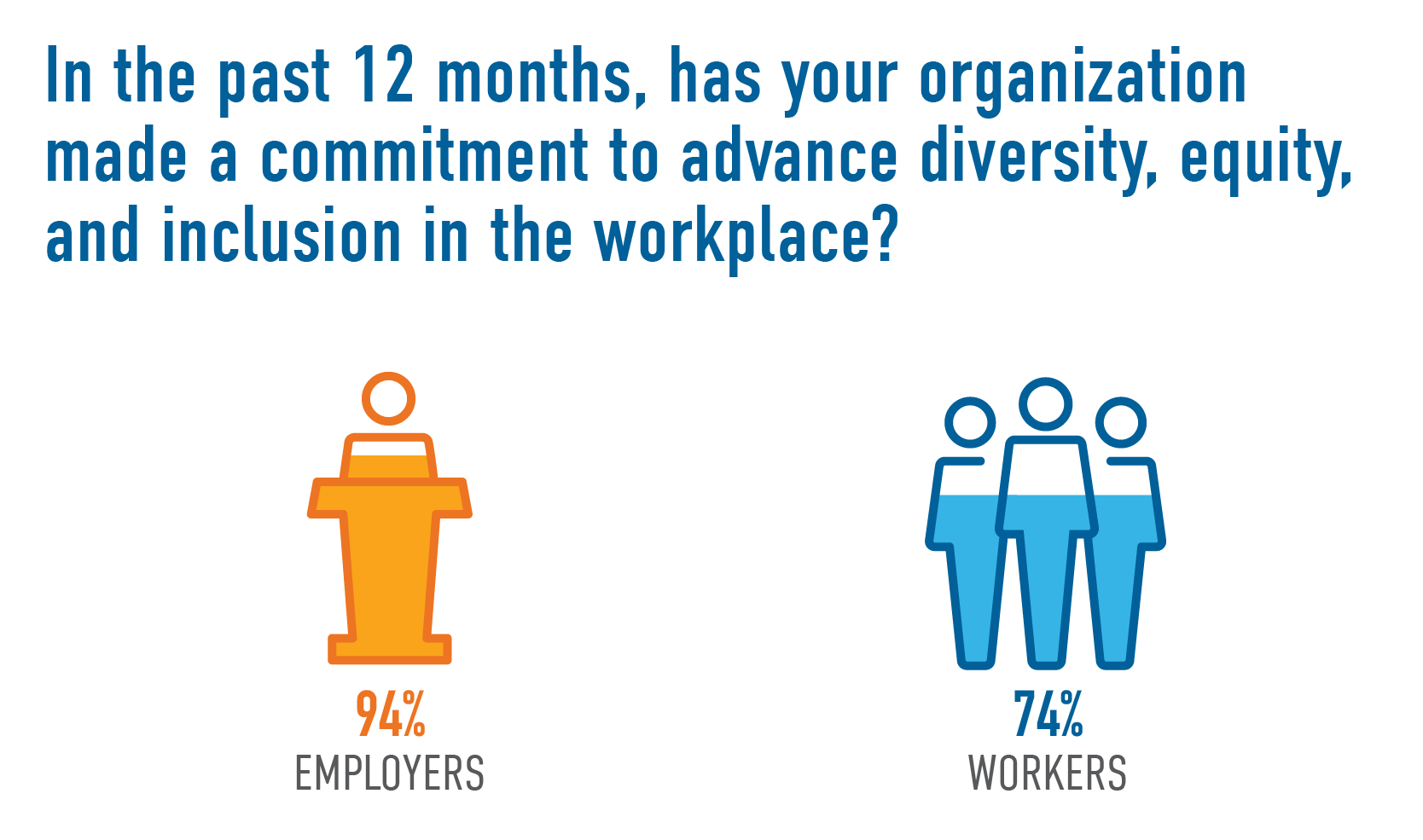
Effectiveness
Generally, both employers and workers are optimistic about the potential for success of these programs, with near universal agreement that formalized programs can be effective in creating a diverse, equitable, and inclusive workplace. Yet when we look at the breakouts for workers across racial lines, we see that there is slightly more skepticism among white and Asian employees (roughly 20% say DEI programs are not effective) than among Black employees (8% say DEI programs are not effective).
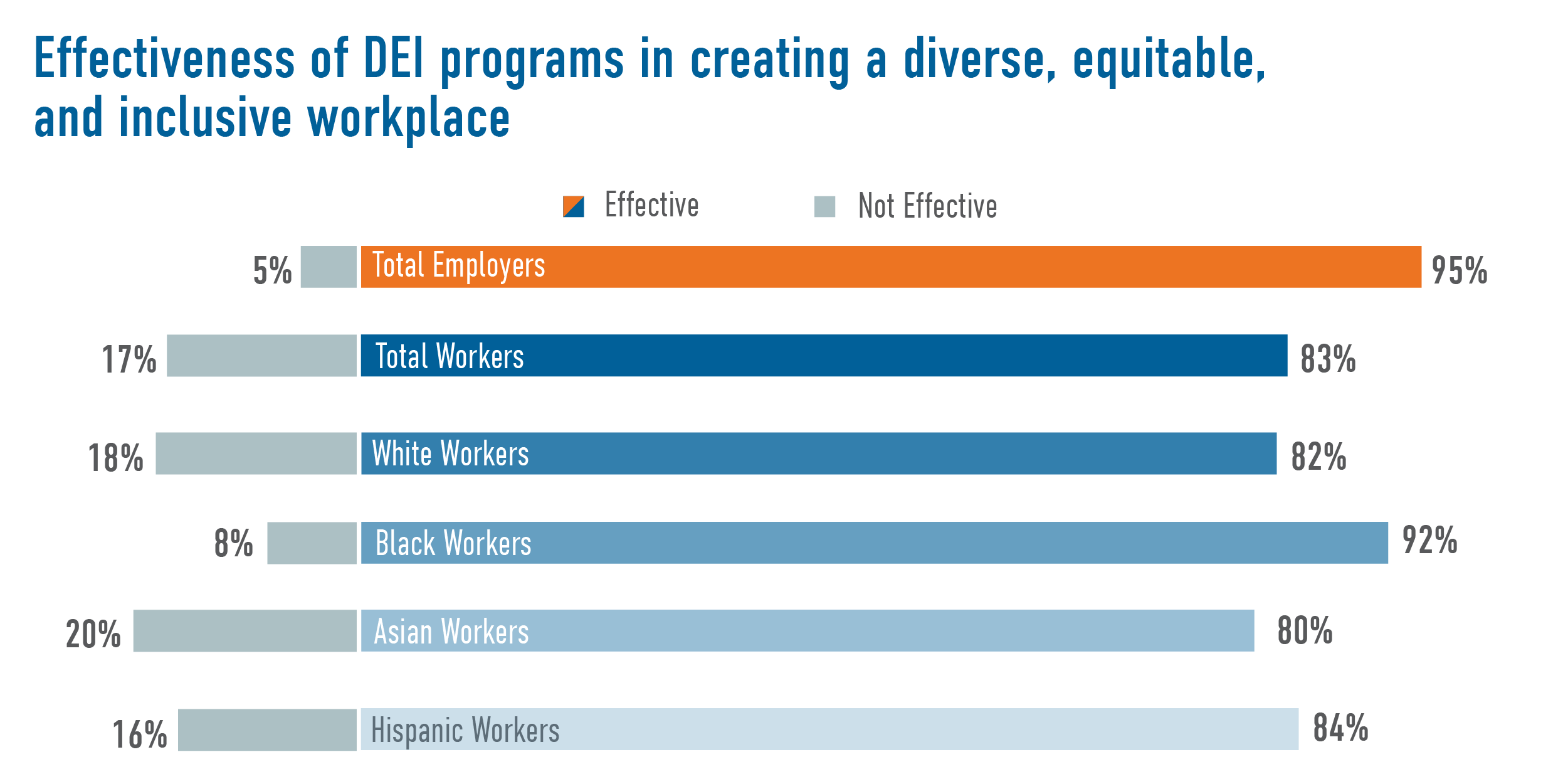
Motivations
Our survey’s respondents also aligned on the reasons their organization might pursue a DEI program. Both workers and employers largely agree that the key motivations for having an institutional DEI policy is to attract and retain diverse talent as well as to make progress toward eliminating bias in the workplace. But many among both groups additionally recognize the importance of multiple stakeholders in driving corporate attention to DEI programming: 49% of employers and 42% of workers view customer expectations as a motivation, and slightly more than half across groups say that responding to employee expectations and improving a company’s reputation in the market are key drivers. These findings demonstrate that rising activism and engagement on DEI issues – from customers, employees, the public, and investors alike – is seen as helping to mobilize corporate action.
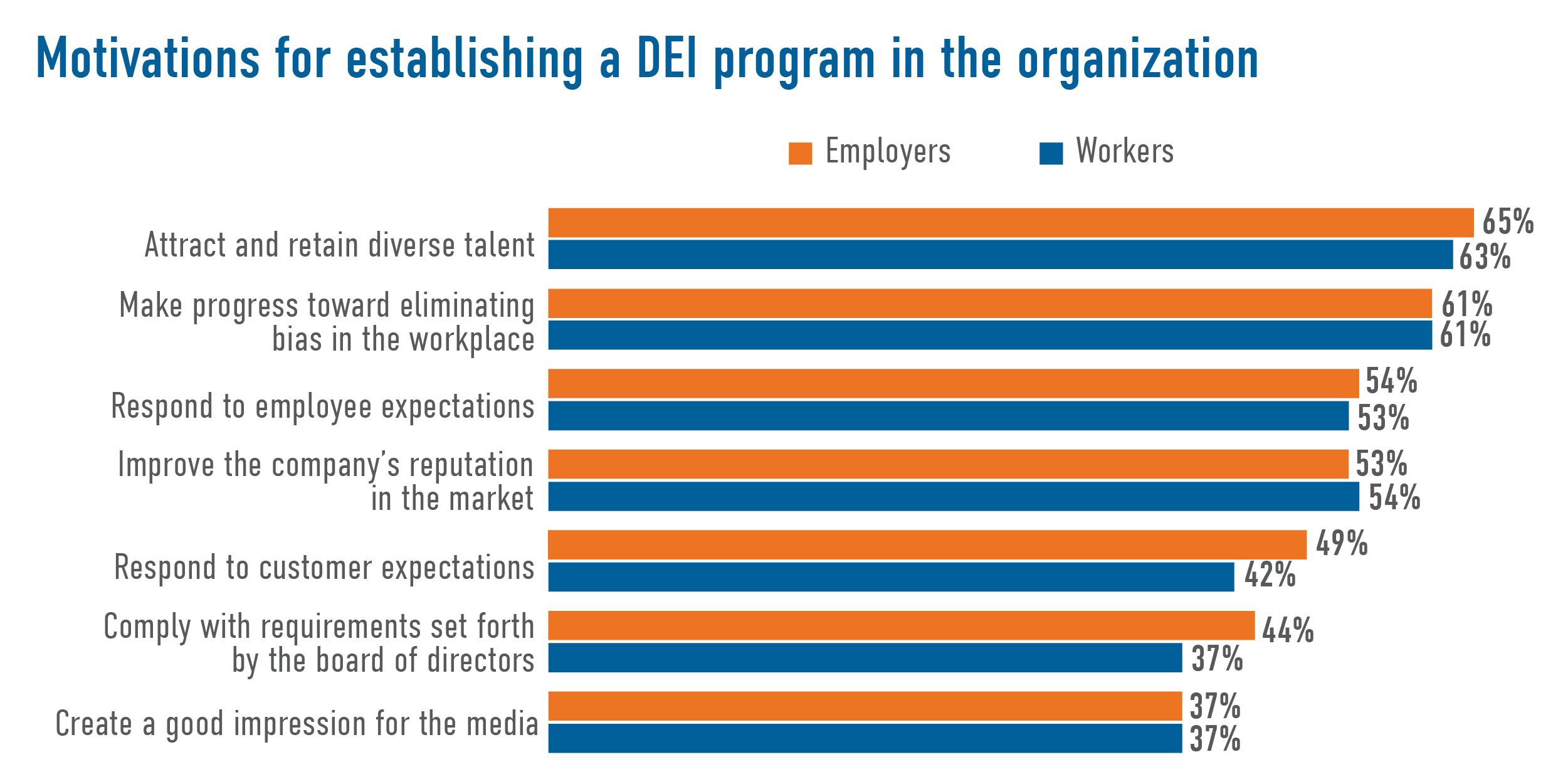
Workforce & Leadership Commitments
A large majority of all respondents viewed their colleagues as embodying their organization’s commitment to DEI, furthering evidence of initial prioritization by companies. More than 90% of workers and employers alike agree that both corporate leaders and employees in their organization have shown a commitment to creating an inclusive environment (50% or more “strongly” agree with both statements), indicating that leadership and employees alike are taking DEI efforts seriously and moving toward “walking the talk.”
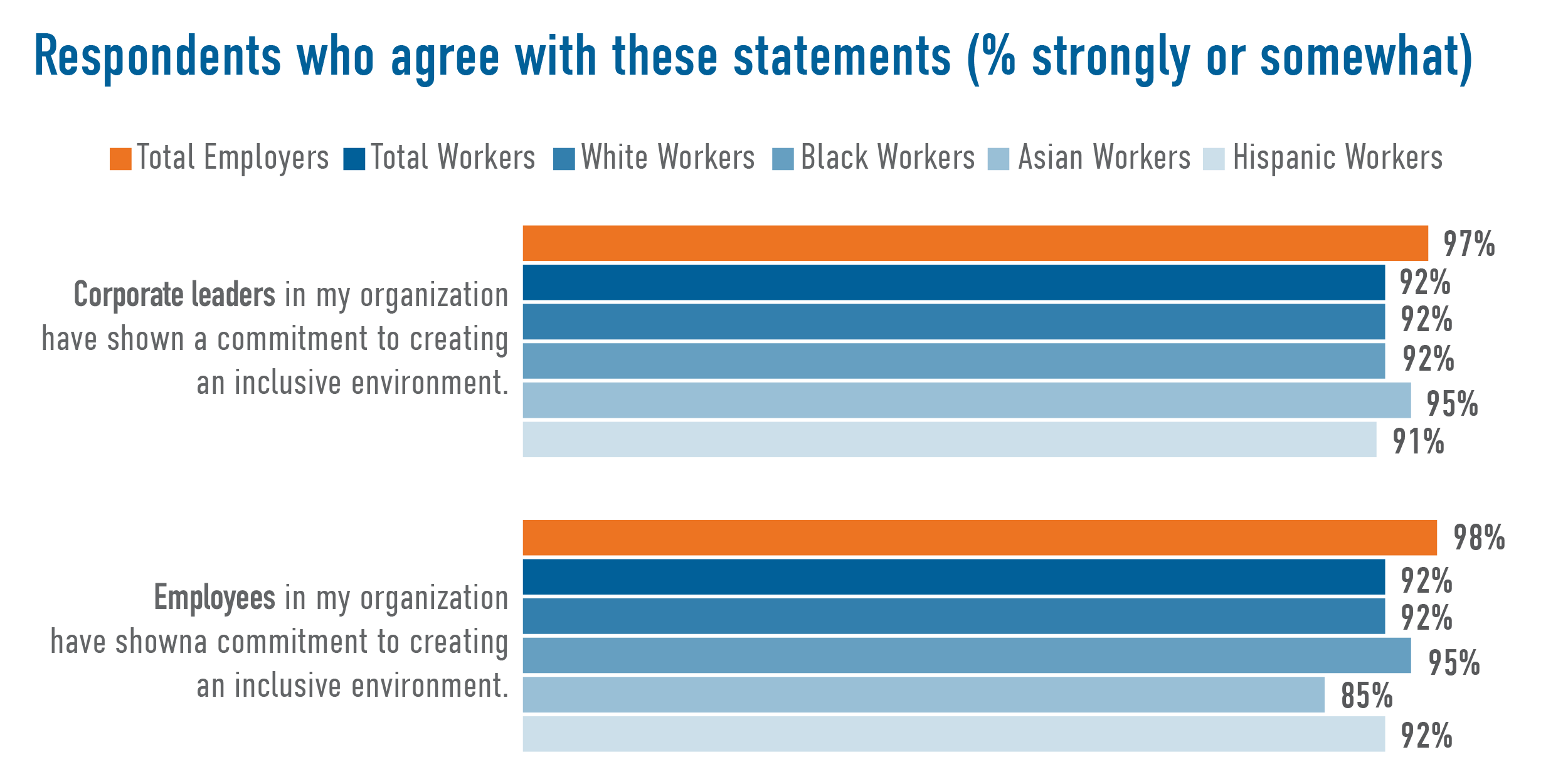
Communications
Communicating progress is a critical piece of an organization’s DEI efforts, as doing so underscores its commitment while also helping employees feel connected to the process. Close to 90% of both groups agree that corporate leadership is clearly communicating why their organization is investing in DEI programs as well as the steps the company is taking to achieve greater diversity, equity, and inclusion, indicating the likelihood of a strong internal communications program embedded within the DEI workstream.
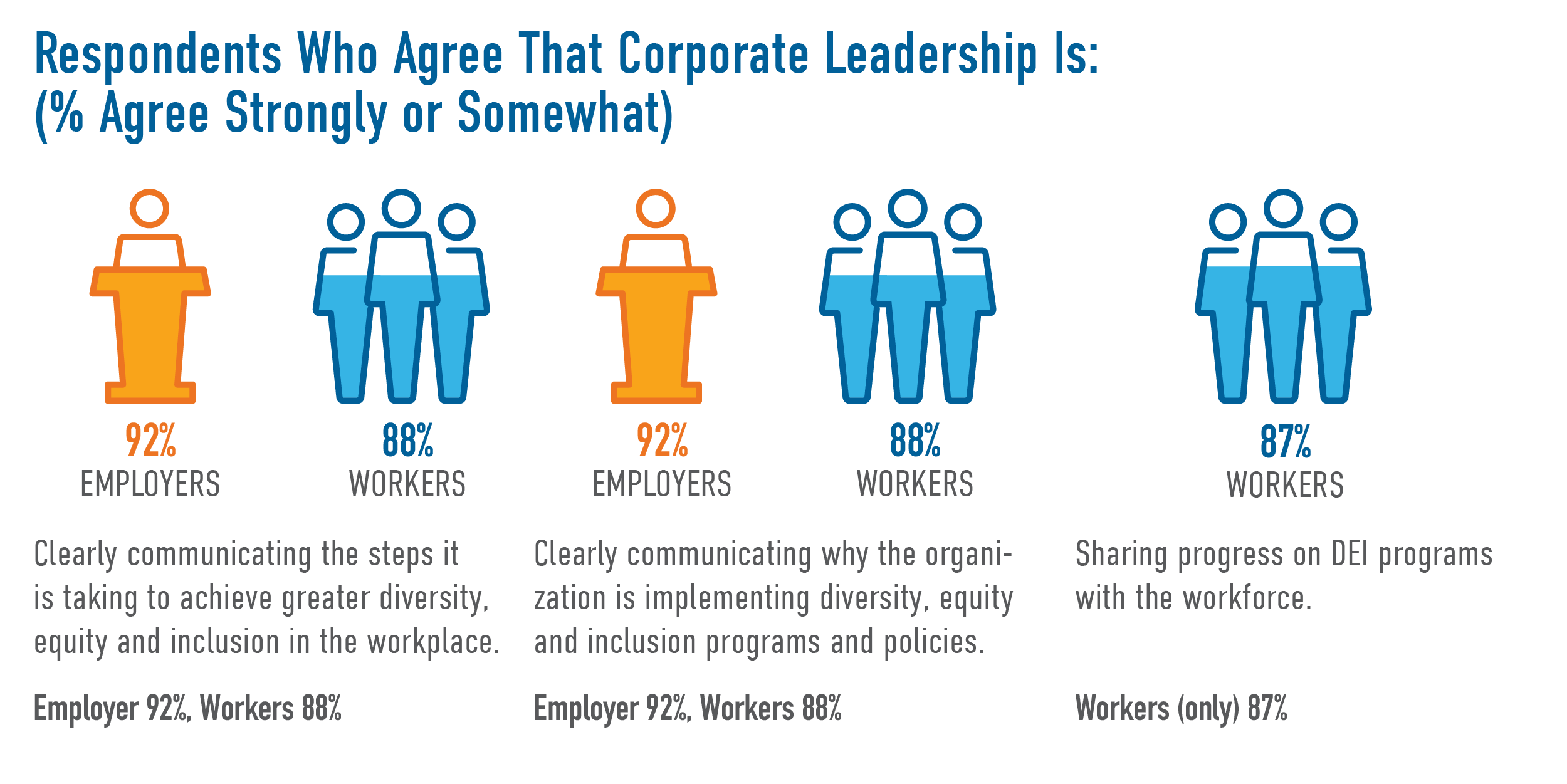
Progress
In terms of overall progress, alignment between workers and employers signals measured optimism about how well these programs are doing so far. While over 40% of both workers and employers indicate that their company is “going above and beyond” in its DEI efforts, a similar percentage signals that their company is progressing but that “there is more work to be done.” Few in either group think the company has not made any progress or is “doing the bare minimum.” These findings track with an Edelman Trust Barometer special report from April 2021, which shows that 42% of Americans polled say corporations are performing well in “getting their own house in order,” a 13-point positive change from the previous six months.
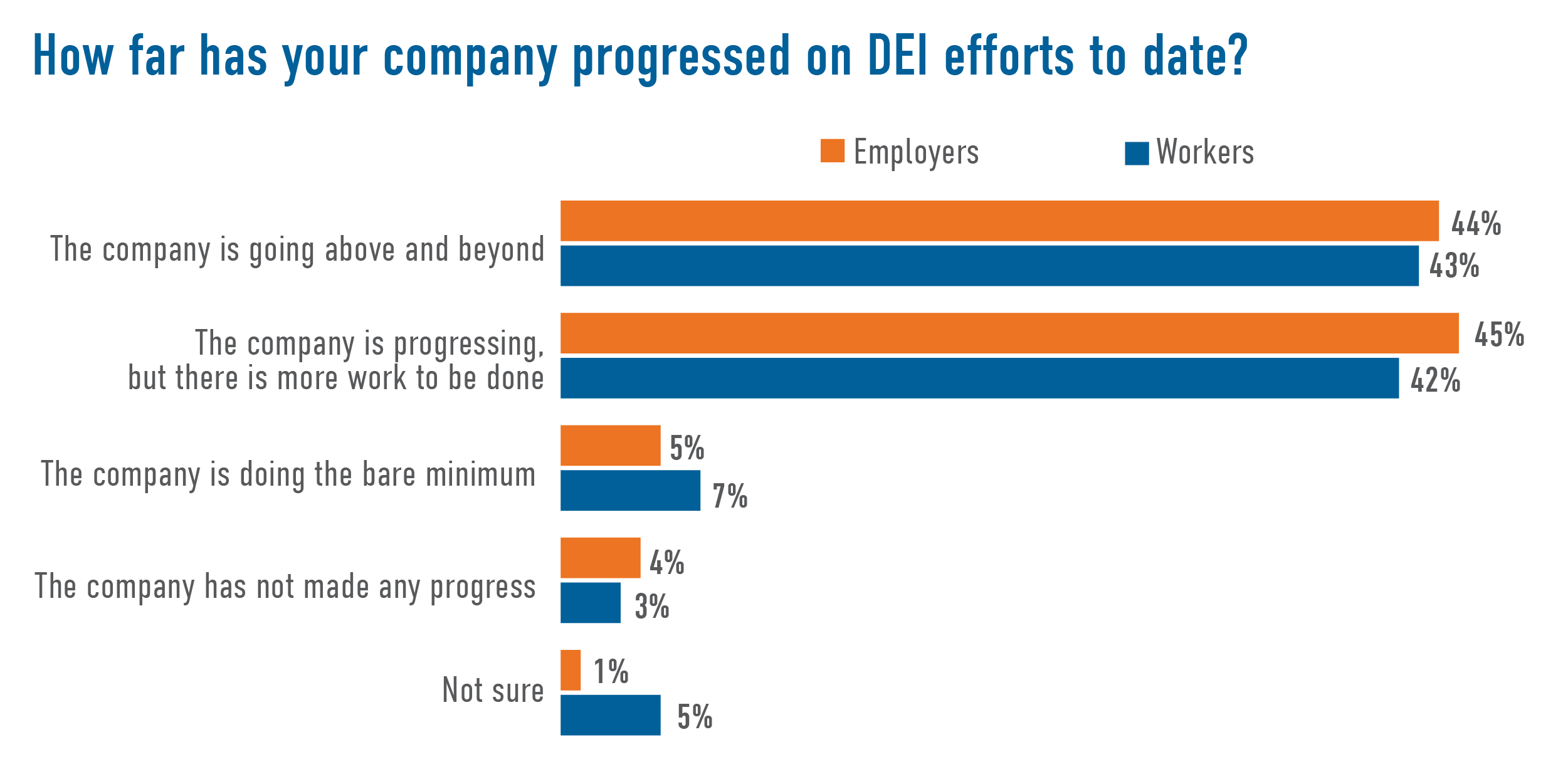
So far, this collection of findings suggests that workers and employers align in their perception of organizational commitment to DEI, initial progress towards that aim, and the general efficacy of DEI programs. But in order to generate meaningful progress toward diversity, equity, and inclusion, companies must consider both the institutionalization and formalization of comprehensive DEI programs. Although employers and workers see that their companies have put some level of workplace DEI initiative in place, questions – particularly among workers – appear to remain about concrete goals, targeted employee engagement, and successful implementation, each of which are necessary to achieve substantive progress. And indeed, making the workplace more diverse and less racist, sexist, ableist, homophobic, and transphobic, as well as more inclusive of the worldviews of all workers, will not be solved solely by an annual implicit bias training. Similarly, a public commitment to increase the racial diversity of board members may not meaningfully move the needle on advancing racial equity.
Importantly, more organizations report accelerating beyond one-off statements or commitments that lack accountability, and our topline poll results indicate that the majority of both employers and workers view their organization as making a formal effort to meet DEI commitments. But as the differing employer and worker perspectives indicate, additional steps are needed to build DEI programming that’s fully integrated and resourced.
Increasing Accountability and Action: Where Divergence Between Workers and Employers Signals Room for Growth
In the following section, we identify the areas where our survey found the greatest divergence between employers and workers in their respective perspectives on DEI in the workplace. We pair those findings with key takeaways from the 2021 CEO Blueprint for Racial Equity to provide additional recommendations, specific to racial equity, that illustrate the foundational steps corporate leaders should take to expand and enhance their general DEI programming to ensure it centers racial equity and to accelerate action and alignment.
While strong majorities of both employers and workers say that their organizations have made a commitment to advance diversity, equity, and inclusion in the workplace, it is worth noting the difference in magnitude between the two groups: 94% of employers report an organizational commitment, 20 points higher than the 74% of workers who do so. Although it is reasonable to believe that those in decision-making leadership roles have greater familiarity with the plans and programs of their companies, transparency and accountability must be the watchwords of equity-focused efforts. The discrepancy in knowledge of company commitments suggests the need for employers to take responsibility for making the company’s equity work highly visible to all employees. Additionally, employers’ perception of what constitutes a commitment to advancing DEI may not meet workers’ expectations. Looking across racial demographics, we see that white workers are most likely to say they are not sure about whether their company has made a commitment to advancing DEI in the workplace; this finding raises questions about why white workers are least certain of their company’s prioritization of DEI.
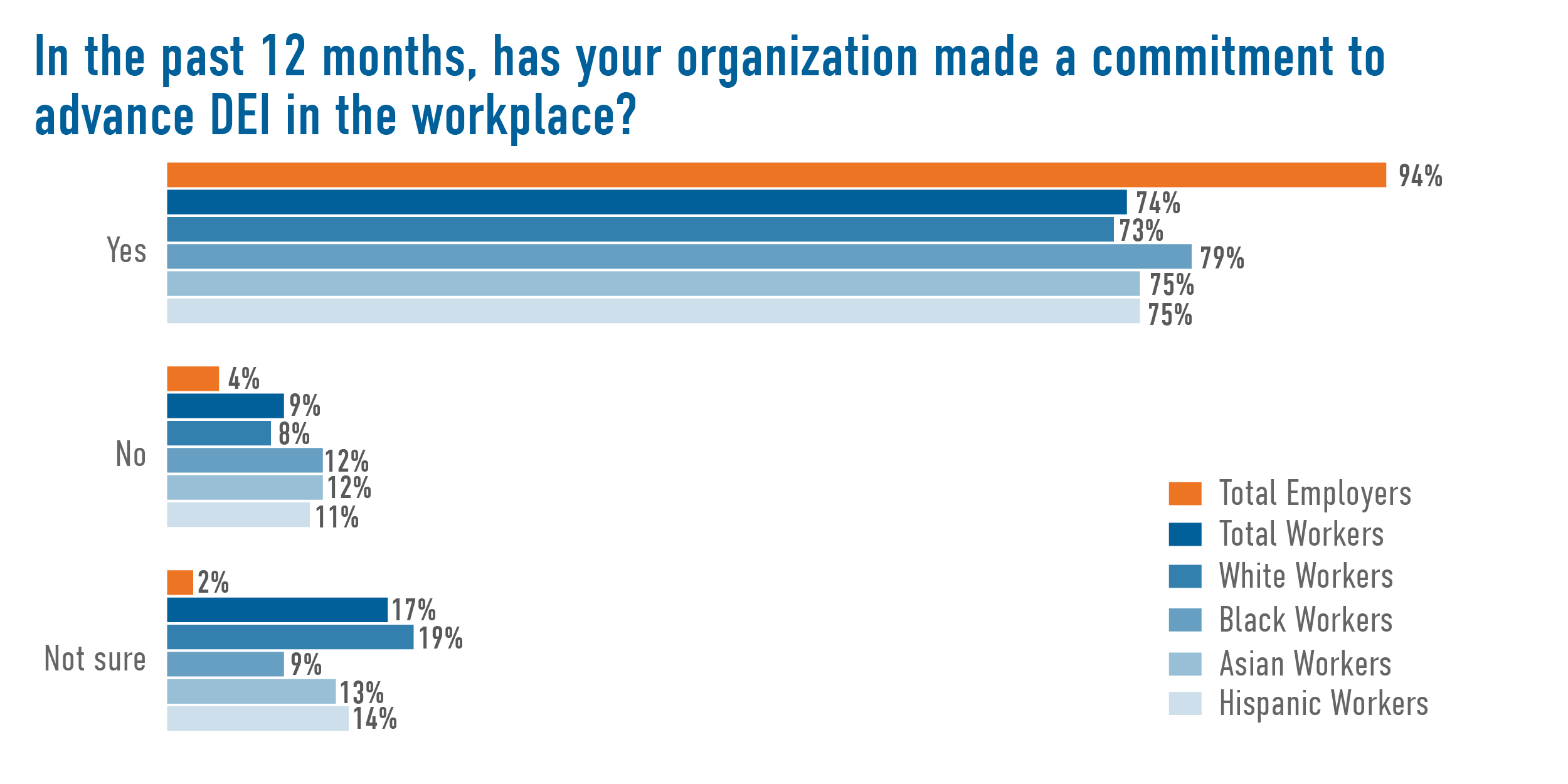
Creating DEI Goals & Plans
We find additional clarity on what might be driving these different perspectives when asking respondent groups how far along they perceive their organization to be in the process of establishing a formal program (i.e. in outlining policies and procedures that advance diversity, equity, and inclusion in the workplace). Here, we see a 20 percentage point difference between employers and workers who say their “Company has created a formal DEI plan with clearly defined goals,” and significantly more workers who say they’re “unsure” where the organization is in the process (26% vs. 3% of employers). So while we saw consensus between employers and workers around their leaders’ and coworkers’ commitment to creating an inclusive environment and a sense of strong internal communication about steps being taken to advance DEI, employees have less clarity around enterprise-wide North Star goals and a clear plan for how they will be achieved.
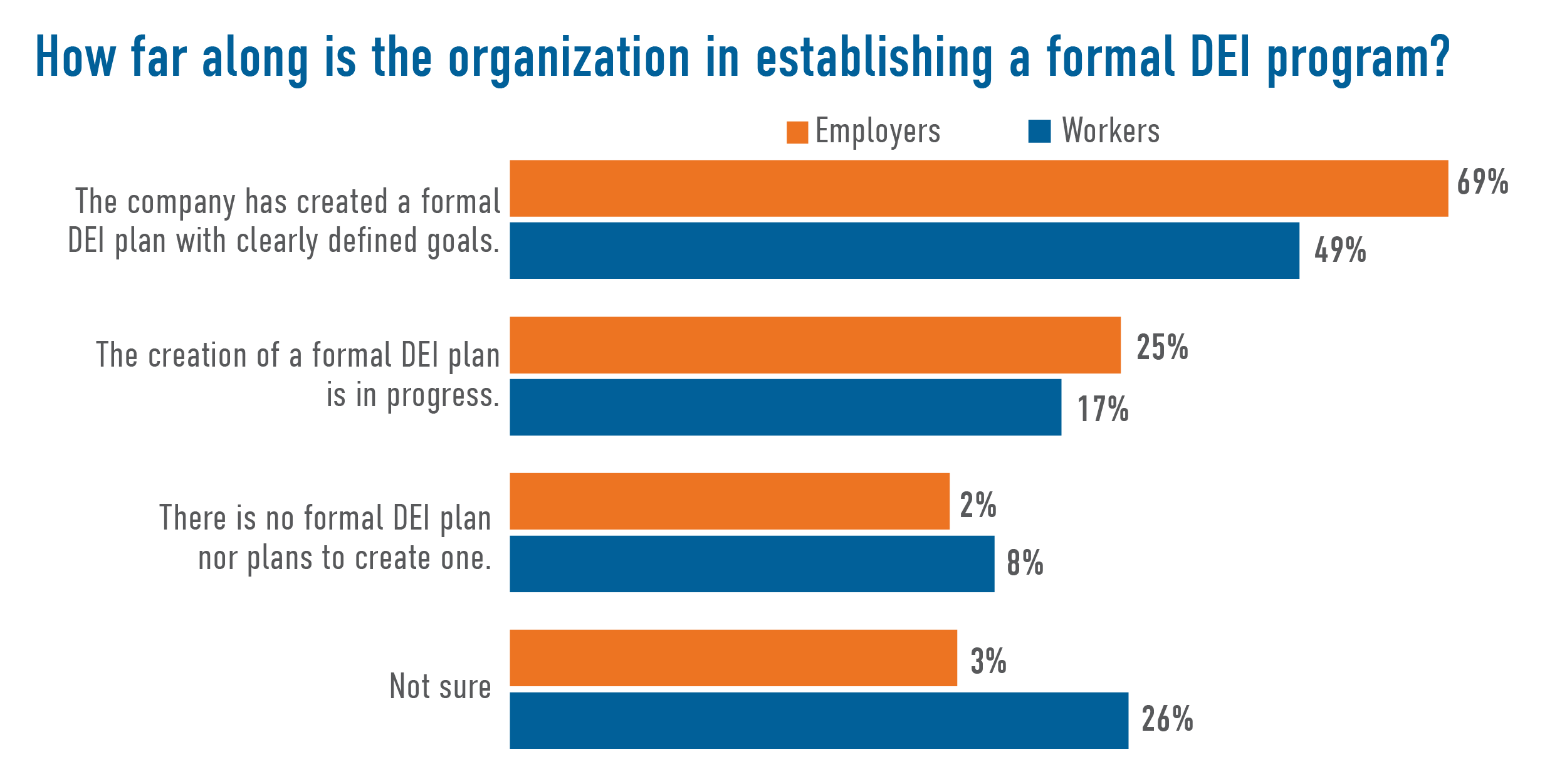
Takeaway: Corporate leaders looking to deepen this work should invest in clearly defining and communicating DEI goals and their company’s plans to achieve them. As we outline in the 2021 CEO Blueprint for Racial Equity, one of the key steps to increasing accountability in DEI work in general, and racial equity work in particular, is to set and publicly disclose specific targets to hire, retain, and promote a racially diverse workforce, leadership, and board that reflect the racial diversity of the nation – and then periodically report on progress made. For example, some corporations have begun by committing to fill at least 25% of their executive roles with people from underrepresented groups by 2025.
The Blueprint also underscores how racial equity programs – which must be at the heart of DEI efforts – cannot begin and end with workforce demographics. Leaders can demonstrate their commitment to the work through steps such as conducting a racial equity audit to better understand the intended and unintended impacts of the company’s policies, practices, and products on people of color and incorporating DEI into a company’s ESG commitments, programs, and metrics. While it’s heartening to know that the majority of respondents across both groups found their coworkers and leaders demonstrating a commitment to inclusion, embedding an enterprise-wide equity lens that both deepens and goes beyond interpersonal trust-building necessitates formalized goals with a transparent accountability mechanism.
Participating in DEI Training
Workers’ uncertainty about their companies’ DEI efforts extends to how far along they are with specific elements of their programs. Though majorities among both workers and employers report that employees at their workplace have participated in a DEI training program (such as unconscious bias or anti-harassment training) in the past year, there is a substantial difference in the percentage of workers (61%) and employers (89%) who say that is the case.
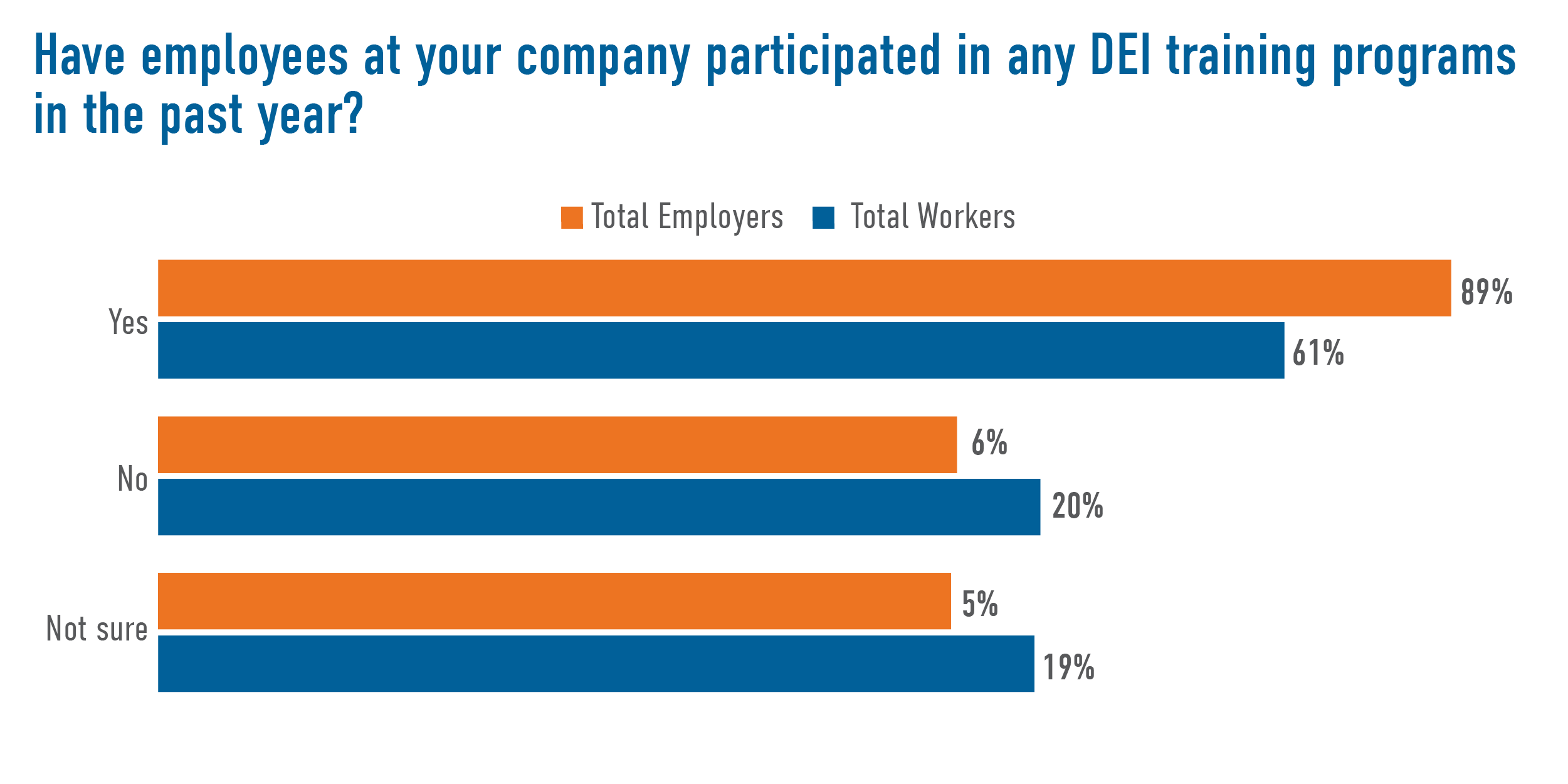
Takeaway: A near 30 percentage point gap between employers and workers who say that employees at their organization have received training suggests that something is amiss. A key insight from the CEO Blueprint is that, in working toward racial equity in particular, corporate leaders must design programs that are actively antiracist, not merely “not racist,” and one means of doing so includes incorporating “antiracism training in onboarding and ongoing learning programs, covering structural racism, implicit racial bias, microaggressions, and trauma-informed leadership practices across all levels of the organization.” Such trainings should include part-time workers, independent contractors, and the board. Those across the organization’s workforce must participate in learning how to proactively substantiate an equitable enterprise through interpersonal interactions, management practices, and policy creation and implementation. When substantially fewer workers than employers report knowledge of ongoing DEI training programs at their organization, it suggests that those trainings are under-utilized, not mandatory, poorly communicated, or confined to a subpopulation among the organization’s workforce. Each of these possibilities undermines the potential for trainings to equip employers and workers alike with the tools and understanding necessary to participate in co-creating an antiracist culture.
Seeking Diverse Inputs into DEI Programs
One explanation for the disconnect between employers and workers on their perceptions of DEI progress could be that a majority of employers aren’t actively seeking input from BIPOC staff and professional third party consultants to the same degree that they are from HR and executives. Just under 30% of employers say employees of color have input into creating DEI programs, whereas 56% of employers report the input of top management. What’s more, only 40% report having a dedicated diversity officer whose specific expertise in the creation of DEI programs could positively impact the organization.
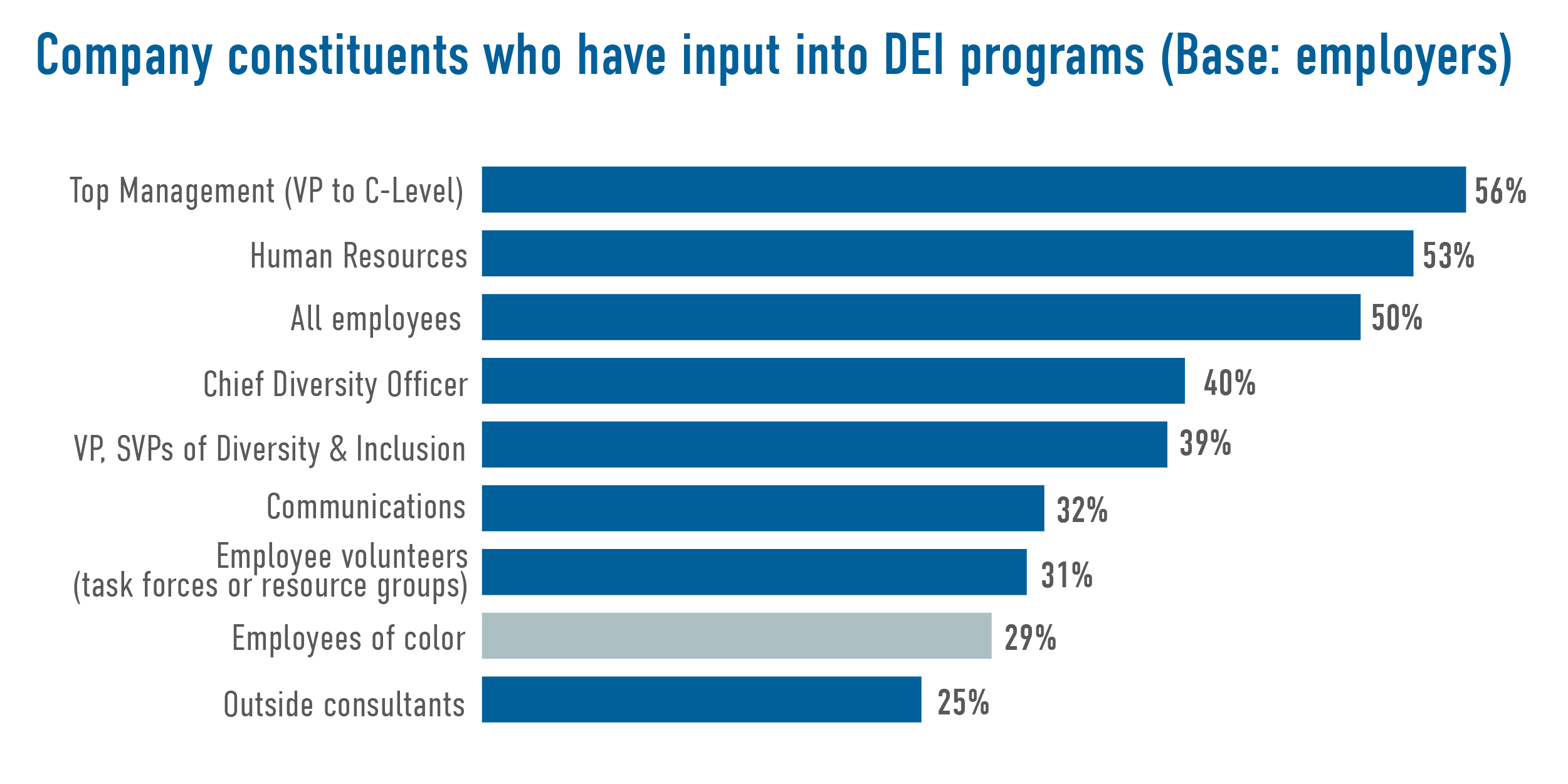
Takeaway: DEI programming must be grounded in a racial equity lens, and the CEO Blueprint for Racial Equity reminds us that a racial equity lens requires intentionally “center[ing] the people who have been most harmed by racist practices and systems” when doing this work. But such centering must not place all responsibility for progress on those who’ve been most harmed. Instead, it should foreground mechanisms that expand worker power and voice, such as by allowing workers to organize and share their concerns and ideas in ways that have substantive impacts on the organization. The Blueprint goes on to explain that, while there is often an ingrained societal suspicion that intentionally supporting marginalized groups hurts others, the opposite is in fact true: When leaders design the circumstances that enable those who have been left behind to participate and contribute fully, everyone wins.
Seeking Feedback from Underrepresented Employees
Similarly, the next chart shows that two-thirds of both employers and workers say leadership sought feedback from “all employees,” yet just one-third say the same about feedback specifically from underrepresented employees, such as racial or ethnic minorities, LGBTQ persons, etc. This begs the question: Is feedback from “all employees” as meaningful as feedback from those groups who have been disproportionately more marginalized in the organization? There is a clear indication that regardless of good intentions, leadership is missing the mark by not directly seeking input on DEI programming from staff with experiential perspectives on organizational inequity and, for core racial equity programming, from BIPOC staff in particular.
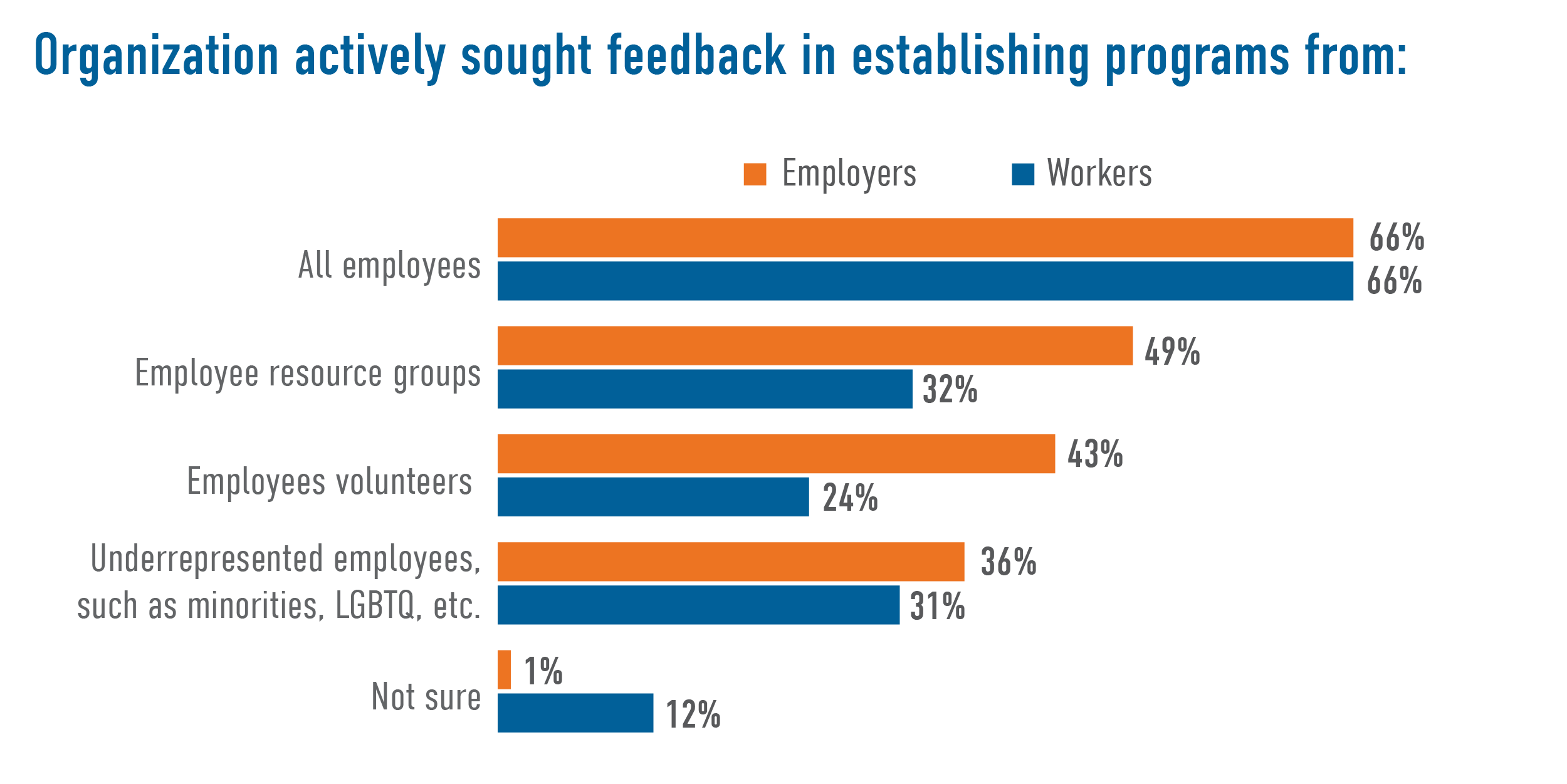
Takeaway: Equity is not a zero sum game. As stated above and referenced in the CEO Blueprint for Racial Equity, when corporate leaders seek input from and address concerns of those who traditionally have been marginalized, everyone can win via “the curb-cut effect.” This Stanford Social Innovation Review article explains that the corollary is also true: “When we ignore the challenges faced by the most vulnerable among us, those challenges, magnified many times over, become a drag on economic growth, prosperity, and national well-being.”
Creating Antiracist Cultures
In the current landscape, there are varying levels of agreement among workers and employers on perceptions of workplace culture, especially as it relates to discrimination, racism, and favoritism. Black workers in particular show the greatest agreement with negative assessments of workplace culture and with the experience of racism within the organization, and employers appear to be aware of these culture challenges, as well.
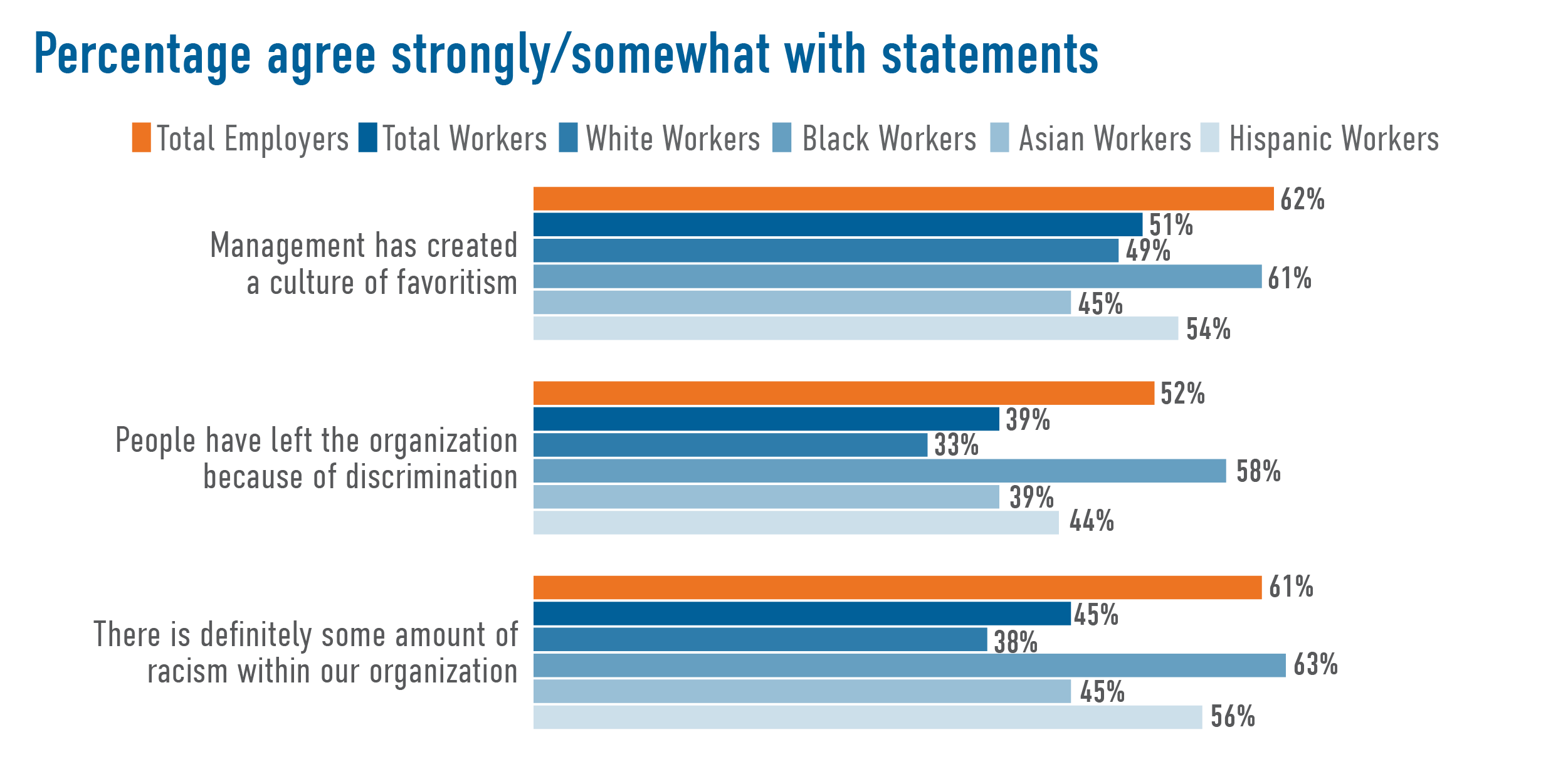
Takeaway: To achieve DEI goals that prioritize racial equity, corporate leaders need to take a consistent pulse of workplace culture and ensure that policies and practices center equity and justice throughout the business by elevating worker voice and feedback mechanisms alongside widespread antiracist trainings and accountability to an antiracist culture of belonging. The CEO Blueprint for Racial Equity explains that companies should “create grievance mechanisms for workers to report discrimination and perceived conflicts with stated values and equity commitments.”
Leaders must be aware that a rarely used existing reporting platform indicates that corporate leaders are not receiving the worker input they need, and that further employee engagement and education on grievance reporting, or more inclusive tools, are vital. It is particularly important that those who handle grievances participate in additional antiracist training, and that all such processes are embedded within building an enterprise-wide antiracist culture with clear goals and an accountability structure.
Taking the Insights Forward
Clearly, diversity, equity, and inclusion is not a one-and-done program siloed within a specific organizational department, but an ongoing, enterprise-wide process requiring constant attention, communication, and refinement, as well as a grounding in racial equity. Even though our and other research has uncovered areas in which leadership needs to spend more time and attention, it is promising that majorities agree that approaches taken by DEI programs can advance the diversity, equity, and inclusion of their workplaces across a number of measures. And, strikingly, Black workers are most confident that DEI programs can result in positive outcomes.
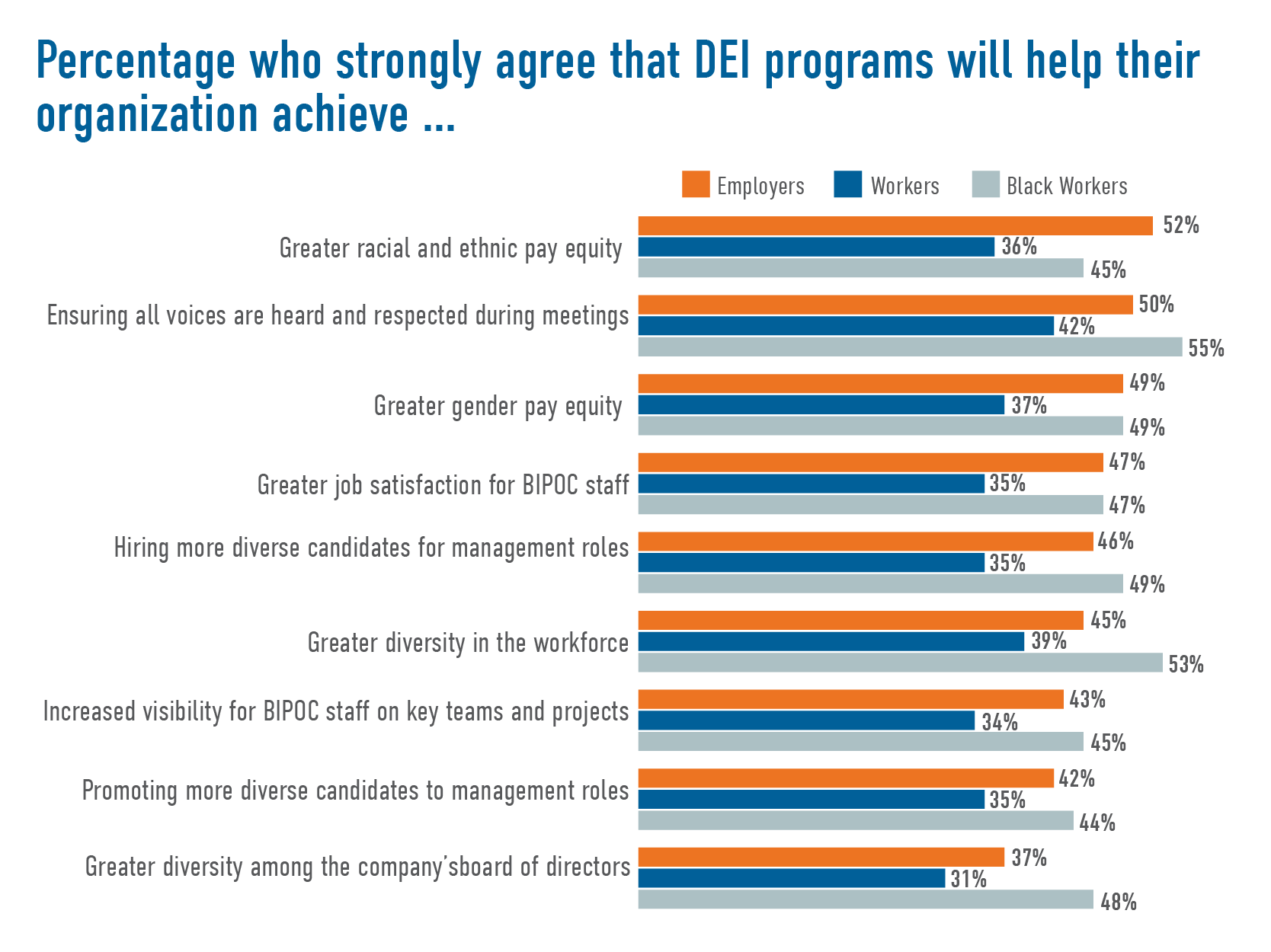
As corporate leaders continue to prioritize DEI in the workplace, it is critically important that they consider the views and perspectives of their workers, which, as we see from this survey research, can vary considerably across demographics and do not always align perfectly with their own. And this work does not end at a company’s front doors. As we outline with our partners in the CEO Blueprint, this work’s necessary prioritization of racial equity requires that companies tackle systemic racism not just within the workplace, but within their communities and across society. With the views of the public as a North Star, corporate America has an unprecedented opportunity to build not just a more equitable workplace, but a more equitable nation that serves us all.
Attribution
This survey was conducted online within the United States by The Harris Poll in partnership with JUST Capital from July 19 to July 29, 2021, among 2,000 U.S. workers ages 18 and older and 150 U.S. employers ages 18 and older. “Workers” are defined as full- or part-time employees at an organization with 500 or more employees, not including government and nonprofits. “Employers” are defined as those who have management-level or higher decision-making responsibility regarding employee issues in an organization with 500 or more employees, not including government and nonprofits.
Previous polling cited was conducted online by The Harris Poll in partnership with JUST Capital from March 11–15, 2021, among 3,024 U.S. adults ages 18 and older. This online survey is not based on a probability sample and therefore no estimate of theoretical sampling error can be calculated. For complete survey methodology, including weighting variables and subgroup sample sizes, please contact Jennifer Tonti, Managing Director of Surveys & Polling.